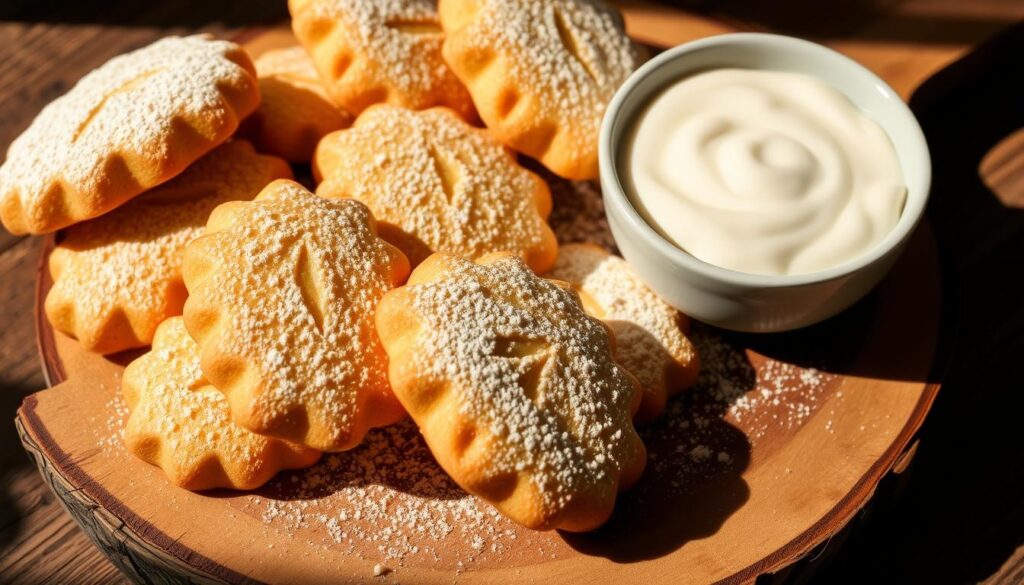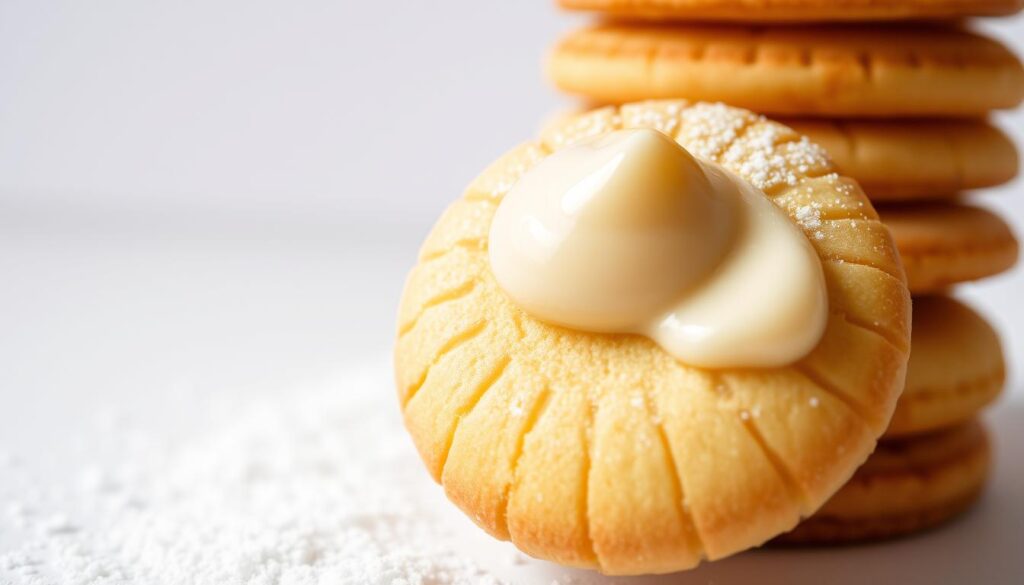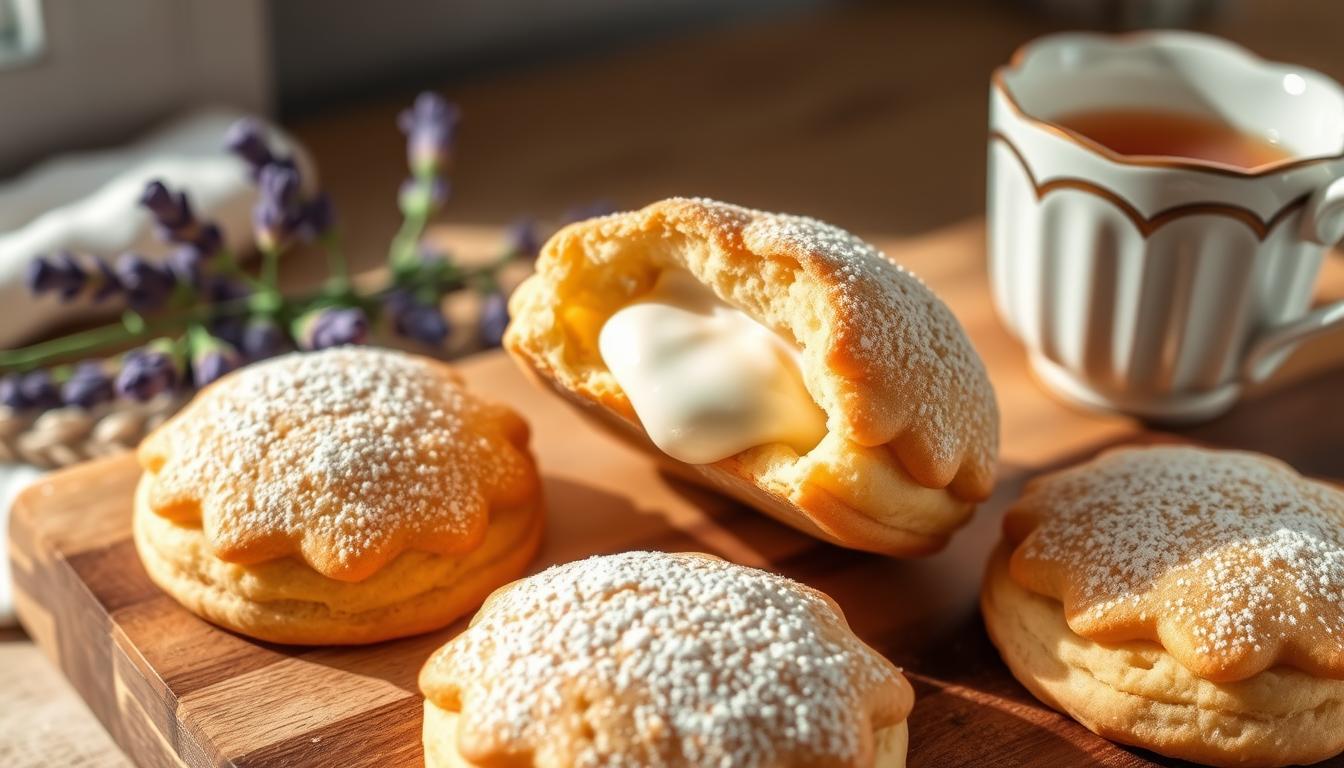How to make Madeline cookies recipe using cream
Madeline cookies recipe using cream
Imagine biting into a delicate, shell-shaped cookie that’s both tender and flavorful. Madeleine cookies have been a French favorite for centuries. Their unique texture and taste have won over bakers worldwide.
Adding cream to the traditional recipe makes these treats even more moist and flavorful. This simple tweak can turn your homemade cookie recipe into something truly special.
Starting this baking journey will bring you joy. You’ll learn to make delicious Madeleine cookies that will wow everyone. Follow this guide to add an extra layer of flavor to your Madeleine cookies with cream.
The History and Charm of Madeleine Cookies
Have you ever wondered where Madeleine cookies come from? These cookies have a long history in France, dating back to the 18th century. They were made with simple ingredients like butter, eggs, and flour.
Origins of the Classic French Delicacy
The authentic madeline cookies recipe comes from French cuisine, in the Lorraine region. They were said to be created by a cook named Madeleine Paulmier in the 18th century. Paulmier worked for a noble family and made these cookies for the Duke de Choiseul’s daughter, Madeleine.
The original recipe used high-quality ingredients like eggs, sugar, and flour. This made the cookies tender and flavorful.
Why Adding Cream Elevates the Traditional Recipe
Adding cream to the traditional recipe makes the cookies even better. The cream makes them moist and tender. It also adds a richness to the flavor, balancing the sweetness.
By adding cream to the classic madeline cookie recipe, you get a more complex flavor. This makes the cookies even more delicious.
Essential Ingredients for Cream-Enhanced Madeleine Cookies
To make the perfect cream-enhanced Madeleine cookies, you need the right ingredients. The quality of your ingredients affects the final texture and flavor of your cookies.
Basic Ingredients List
The basic ingredients for these cookies include all-purpose flour, granulated sugar, unsalted butter, eggs, and heavy cream. You’ll also need baking powder, salt, and a bit of vanilla extract for extra flavor.
| Ingredient | Quantity | Purpose |
|---|---|---|
| All-purpose flour | 1 1/2 cups | Provides structure |
| Granulated sugar | 1 cup | Adds sweetness and tenderness |
| Unsalted butter | 1/2 cup | Contributes to flavor and texture |
| Eggs | 2 large eggs | Binds ingredients and adds moisture |
| Heavy cream | 1/2 cup | Enhances moisture and tenderness |
Choosing the Right Type of Cream
Heavy cream is best for its richness and moisture. Its high fat content makes your Madeleines tender and delicate.
Ingredient Substitutions and Alternatives
If you have dietary restrictions, there are alternatives. You can use almond flour instead of all-purpose flour and coconut sugar for granulated sugar. For a dairy-free option, try almond milk or soy cream instead of heavy cream.
By choosing your ingredients wisely and making substitutions, you can make delicious cream-enhanced Madeleine cookies. These can suit different tastes and dietary needs.
Kitchen Tools and Equipment You’ll Need
To bake Madeleine cookies with cream, you’ll need some essential kitchen tools and equipment. Having the right tools will ensure that your Madeleines turn out perfectly and that the process is enjoyable.
Essential Baking Tools
You will need a few basic baking tools to get started. These include a mixing bowl, measuring cups, and a whisk. A high-quality mixer is also recommended, as it will make the process of creaming the butter and sugar much easier.
According to renowned pastry chef,
“The quality of your mixing tools can greatly affect the final texture of your Madeleines.”
A rubber spatula is also essential for scraping the sides of the bowl and ensuring all ingredients are well incorporated.
Madeleine Pan Options and Alternatives
A Madeleine pan is a specialized baking pan that gives Madeleines their characteristic shell shape. If you don’t have a Madeleine pan, you can consider alternatives such as a mini muffin pan or a cake pan, though the results may vary.
| Tool/Equipment | Description | Importance |
|---|---|---|
| Mixing Bowl | Stainless steel or glass bowl for mixing ingredients | High |
| Measuring Cups | Accurate measurement of ingredients | High |
| Whisk | For mixing and blending ingredients | Medium |
| Madeleine Pan | Specialized pan for achieving the signature Madeleine shape | High |
Investing in a good-quality Madeleine pan will pay off if you plan on baking these cookies frequently. But if you’re just starting out, you can experiment with alternatives.
Madeline Cookies Recipe Using Cream: Step-by-Step Instructions
To make homemade madeline cookies with a delightful twist, you’ll follow a simple recipe. It adds cream for extra flavor and moisture.
Preparing Your Ingredients
The first step is to prepare your ingredients. You’ll need all-purpose flour, granulated sugar, eggs, and heavy cream. Make sure all ingredients are at room temperature for smooth mixing.
Here’s a list of the ingredients you’ll need:
- 1 1/2 cups all-purpose flour
- 1 cup granulated sugar
- 3 large eggs
- 1/2 cup heavy cream
- 1/4 teaspoon salt
- 1/2 teaspoon baking powder
- 1/2 teaspoon vanilla extract
Mixing the Batter
Mixing the batter is key. In a large bowl, mix the eggs and sugar until smooth. Then, add the flour, salt, and baking powder gradually. Mix until just combined.
Next, add the heavy cream and vanilla extract. Mix until the batter is smooth and lump-free.

The Crucial Resting Period
The batter needs to rest to get the signature “hump” on your madeline cookies. Cover the bowl with plastic wrap and refrigerate for at least 2 hours or overnight. This step makes the cookies tender.
Filling the Madeleine Molds
After resting, fill the madeleine molds. Use a piping bag or spoon to fill each mold about 3/4 full. Smooth out the batter for even baking.
Here’s a table summarizing the steps for filling the madeleine molds:
| Step | Description |
|---|---|
| 1 | Prepare your piping bag or spoon with the rested batter. |
| 2 | Fill each madeleine mold about 3/4 full. |
| 3 | Smooth out the batter to ensure even baking. |
By following these steps, you’ll make delicious homemade madeline cookies with cream. The cream adds moisture and flavor, making them impressive.
Baking Techniques for Perfect Madeleines
Baking Madeleines is all about temperature and timing. To get them just right, you need to know the baking tricks that make these French cookies special.
Optimal Oven Temperature and Positioning
Getting your oven to the right temperature is key for that perfect “hump” on your Madeleines. Aim for 375°F (190°C). Make sure your oven is really at that temperature to avoid mistakes. Place the Madeleine pan in the oven’s center for even baking.
Pierre Hermé, a famous pastry chef, says, “The secret to great Madeleines is precise oven temperature and top-notch ingredients.”
“Baking is not just about following a recipe. It’s about knowing the science behind it,” Hermé explains.
Timing and Visual Cues for Doneness
Timing is critical when baking Madeleines. They usually take 10-12 minutes. But, your oven might be different. Watch them closely and look for signs of doneness. A golden edge and a lightly colored center are good signs. The “hump” should also be visible.
| Baking Time (minutes) | Visual Cue | Doneness Indicator |
|---|---|---|
| 10 | Light golden edges | Edges set, center slightly soft |
| 11 | Golden brown edges | Center lightly colored, hump visible |
| 12 | Deep golden edges | Fully cooked, hump pronounced |
Achieving the Signature “Hump”
The “hump” on Madeleines comes from good batter and precise baking. Rest your batter well to relax the gluten. A hot oven helps the edges set fast while the center rises, creating the hump. Don’t overmix the batter and make sure the pan is well buttered and floured.
Mastering these baking techniques will help you make perfect Madeleines. Try the madeline cookies recipe using cream to find your favorite taste and texture.
How Cream Affects Texture and Flavor
Adding cream to your Madeleine cookie recipe makes a big difference. It adds richness and tenderness, making the cookies better.
The Science Behind Cream in Baking
Cream changes the dough’s chemistry in baking. Its fat stops gluten from forming, making the cookies soft. It also has casein, a protein that strengthens the cookies.
Moisture and Tenderness Benefits
Cream’s moisture makes the cookies tender and keeps them fresh longer. The fat in cream also keeps them soft by slowing down starch changes.

Flavor Enhancement Properties
Cream adds a rich taste to Madeleine cookies. It also helps flavors mix better, making the cookies taste more complex and satisfying.
Let’s compare cream-enhanced Madeleines to traditional ones:
| Characteristics | Traditional Madeleines | Cream-Enhanced Madeleines |
|---|---|---|
| Texture | Dense, dry | Tender, moist |
| Flavor | Simple, sweet | Rich, complex |
| Freshness Retention | Short shelf life | Longer freshness |
Using cream in your classic madeline cookie recipe makes your cookies better. Try different creams to see what works best for you.
Flavor Variations for Cream-Based Madeleines
Try different flavors to make your cream-based Madeleines even better. Adding various ingredients to the batter can lead to many tasty variations.
Madeleines are very versatile. You can mix in different essences, zests, or spices. This lets you create unique flavors.
Citrus-Infused Variations
Adding citrus flavors can make your Madeleines bright and refreshing. Use orange zest and lemon juice for a citrusy twist. Just add the zest of one orange or lemon to the batter and adjust the sugar.
Chocolate and Cocoa Options
Chocolate fans will love adding cocoa powder or melted chocolate to the batter. You can also dip them in chocolate for more flavor. High-quality cocoa powder gives a deeper chocolate taste.
Spiced Madeleines for Special Occasions
Spices like cinnamon, nutmeg, or cardamom add warmth and depth. They’re great for special occasions or holidays. Try different spice mixes to find your favorite.
Here’s a quick look at the flavor variations we’ve talked about, along with some more ideas:
| Flavor Variation | Ingredients to Add | Tips |
|---|---|---|
| Citrus | Orange or lemon zest, juice | Adjust sugar content |
| Chocolate | Cocoa powder, melted chocolate | Use high-quality cocoa |
| Spiced | Cinnamon, nutmeg, cardamom | Experiment with combinations |
| Nutty | Almond extract, chopped nuts | Enhances texture and flavor |
| Fruit-Infused | Raspberry, strawberry puree | Adjust liquid content |
Exploring these flavor variations can make your baking more exciting. You can create a wide range of Madeleines that everyone will love.
Creating Delicious Glazes and Toppings
Madeleine cookies become irresistible with the right glazes and toppings. Adding a glaze or topping boosts flavor and looks. It makes your homemade madeline cookies stand out.
A good glaze or topping can turn your baked goods into something special. Here are some ideas to enhance your Madeleine cookies.
Simple Sugar Glaze
A simple sugar glaze is a classic choice. You need powdered sugar and a bit of milk or water. The trick is to get the right consistency. You can also add a pinch of salt to balance the sweetness.
Chocolate Dipping Techniques
Chocolate lovers will love dipping Madeleine cookies in chocolate. You can use dark, milk, or white chocolate. To get a smooth coat, melt the chocolate carefully in a double boiler or in the microwave.
Decorative Finishing Touches
For extra elegance, try decorative touches. Sprinkle powdered sugar, chopped nuts, or edible gold dust on top. These small details can make a big difference.
By adding these glazes and toppings to your madeline biscuit recipe with cream, you’ll make delicious and beautiful Madeleine cookies.
Troubleshooting Common Madeleine Baking Issues
Mastering Madeleine baking means solving common problems. Even with the best ingredients and tools, issues can pop up. We’ll cover some common problems and offer solutions to get your Madeleines just right.
Fixing Flat or Humpless Madeleines
Madeleines are known for their “hump.” If yours are flat, it might be from overmixing or wrong oven temperature. Don’t overmix the batter, as it can flatten the cookies. Also, check your oven temperature with a thermometer to get it right.
Addressing Sticking Problems
Madeleines sticking to the pan is a common problem. To avoid this, thoroughly butter and flour your Madeleine pan. Using a non-stick pan or silicone mold can also help. If they’re sticking, your batter might be too wet.
Resolving Texture and Flavor Concerns
Texture or flavor issues might come from bad ingredients or technique. Use fresh, high-quality ingredients and avoid overbaking. Adding cream, as we’ve talked about, can improve both texture and taste. If problems persist, try adjusting the cream or other ingredients to get it right.
By tackling these common problems, you’ll be on your way to baking perfect Madeleines with cream. For an easy madeline cookies recipe and to make the best madeline cookies with cream, keep practicing and stay patient.
Conclusion: Mastering the Art of Cream-Enhanced Madeleine Cookies
You now know how to make amazing Madeleine cookies with cream. This makes the classic French treat even better. You’ve learned to make them softer and tastier.
The recipe for madeline cookies with cream is ready for you. You can try different flavors and glazes. The more you bake, the better you’ll get.
These cookies will wow anyone you share them with. So, feel free to get creative. The world of Madeleine cookies is waiting for you to discover.

